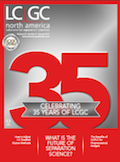Having It All, and with Any Mass Spectrometer
Special Issues
Richard D. Smith

The challenges in the analysis of complex biological and environmental samples are open-ended: We want from our separations (and often truly need) more resolution, greater peak capacity, higher reproducibility, faster speed, and the ability to work with smaller and smaller samples. For detection, and specifically with mass spectrometry (MS), we want greater measurement sensitivity, wider dynamic range, better interface robustness with the separation, more effective compound identification, and improved precision and accuracy of quantification.
While significant progress has been made at individually addressing each of these desires, advances that combine these attributes have been far less common, and approaches that address most (or all) of these desires have been elusive. Such a convergence of capabilities would have profound impacts in broad areas, ranging from biological research to clinical practice. For example, this combination would enable not only much greater throughput, but also much better effectiveness in areas such as proteomics and metabolomics measurements.
I am confident that such analytical advances are now on the horizon, and that they will be broadly disruptive in areas where the best approaches currently involve the combination of a separation approach, particularly liquid chromatography (LC) with MS. Further, I believe these advances will be based upon new developments related to ion mobility (IM) separations (1).
Recent years have seen not only the increasing use of IM with MS, but also a proliferation of IM formats with quite different attributes, and their growing mainstream commercial availability (1). At present, the most broadly useful platforms insert a drift tube or traveling-wave IM stage between the conventional separation (LC) and MS systems, most notably an inherently fast time-of-flight (TOF) MS system for broad (that is, nontargeted) analyses. Despite this development, it really is early days for IM-MS; a phase typically marked by much interest and exploration of possible applications. However, to this point there have been only the earliest hints of a possible transition to its wide and routine use.
IM has long been recognized as having many attractive features. It is extremely fast, with separations typically on a millisecond timescale. Since separations take place in a gas using electric fields, IM avoids analyte ion contact with surfaces and can achieve levels of reproducibility not feasible with chromatography. IM-MS-derived collision cross sections provide important information on analyte ion size and shape. Because IM is conducted after sample ionization, it is a natural adjunct to MS with insertion between the ionization and m/z analysis stages, generally requiring only modest increases in platform complexity. As a result, recent advances in MS ion utilization efficiency can be used, and it thus becomes practical to work with far smaller sample sizes than is generally feasible with conventional condensed phase separations. Finally, IM is broadly applicable, in many cases using nitrogen as a “pseudo-stationary phase” for applications that can span fields such as proteomics, metabolomics, lipidomics, and glycomics-and even multiplexing such measurements in a single run.
Despite these attributes, IM has some well-recognized deficiencies. Most significant is its relatively low separation (or resolving) power and achievable peak capacities, with both typically under 100. And while greater resolving powers and peak capacities (for example, several hundred) have been achieved by individual labs, these advances have only been made in conjunction with some combination of greatly reduced sensitivity (or ion losses) and substantially reduced speed. Related issues involve limitations to the analyte ion mobility range covered, the need to slowly “scan” mobilities for some IM formats, and the restriction of the size of ion populations that can be injected for a separation because of ion volume and space charge limitations (as in drift tube IM measurements), which result in very limited signal-to-noise ratios or the common practice of summing data for long time periods.
However, I believe disruptive changes are on the horizon based on recent developments in IM separations conducted in structures for lossless ion manipulations (SLIM) that can address all these deficiencies simultaneously (2–11). The SLIM approach represents a dramatic departure in how ions in gases are manipulated, allowing for the creation of devices using previously impossible sets of complex and integrated (but also efficient) ion manipulations. SLIM are literally constructed from electric fields: SLIM use large electrode arrays patterned on two planar surfaces to create radio frequency and direct current ion confining fields. Additional superimposed electric fields enable not only IM separations, but also the ability to efficiently transmit ions through turns, switch them between paths, and store them over long times (that is, hours) without losses (2)!
The significance of these advances was greatly amplified by SLIM utilizing traveling waves (TW). Such IM separations are based on the mobility-dependent ability of ions to “keep up” with the TW (3). The relatively low voltages needed for TW removed the pathlength limitation and enabled the design of long, but compact serpentine IM paths (4). This design improvement considerably amplified the achievable IM resolution, avoiding the increasingly high voltages necessary in drift tube IM, which limits their maximum practical pathlength to only ~1 m. A 13-m SLIM IM path design provided resolution more than five times greater than that achieved using the best drift tube IM alternative, enabling baseline resolution of structurally similar and previously challenging isomers (5-7).
Building on this advance, we recently developed a SLIM serpentine ultralong path with extended routing (SUPER) platform for even higher resolution IM in conjunction with MS (8). This SLIM SUPER IM-MS utilizes a 13-m serpentine long-path drift length with an “ion switch” at the end to route ions either to the MS system or back to the beginning of the serpentine path. This “multipass” SLIM SUPER IM-MS platform provides much longer IM drift paths while still maintaining essentially lossless ion transmission. Recent developments have also established the feasibility of creating multilevel three-dimensional (3D) SLIM for constructing compact ultralong IM paths (9).
However, there are a few other somewhat subtle but crucially important issues. These are related to gradual IM peak dispersion (because of diffusion and other factors for ultralong separation paths) and the maximum ion population sizes that can be injected for a single IM separation. These issues result in limitations on essentially all key performance metrics, including achievable resolution, mobility range, detection dynamic range, and signal-to-noise ratios.
It turns out that these two remaining issues can both be addressed by a new SLIM capability allowing temporal and spatial compression or “squeezing” of any ion distribution, including complete IM separations, without losses of IM resolution and to an extent limited only by the physics of ion space charge (10). This compression ratio ion mobility programming (CRIMP) process provides greater signal intensities and reduced peak widths, thus optimizing MS detection, and enabling the use of much longer pathlengths. In SLIM, ions are naturally distributed in “bins” created by the TW, with an IM peak generally spanning many bins. With CRIMP, a “traveling trap” (TT) region that utilizes a normal TW is interfaced with a “stuttering trap” (ST) region in which the TW is periodically paused, allowing ions from multiple TW bins in the TT region to merge into a single bin in the ST region as they move through the interface between the two regions. The repetition of this process thus spatially compresses any incoming ion population in a lossless fashion. Dynamic switching of the ST region from a stuttering TW mode back to the normal TT mode of operation “locks in” the spatial compression, allowing for continuation of the IM separation, albeit with narrowed peak widths and increased peak intensities. We recently illustrated that CRIMP with SLIM greatly expands capabilities for both ion accumulation and ion injection (11). It has also enabled both in a fashion that is fully compatible with IM separations. These developments have allowed more than 5 billion ions to be accumulated, providing more than a 100-fold increase in IM-MS sensitivity compared to the best results achieved previously (11).
In conclusion, the conflicting challenges posed by our desired separation and detection improvements now seem quite surmountable: SLIM-based IM-MS appears to provide a straightforward path to broadly effective, and likely disruptive, new capabilities with impacts across a broad range of applications. Time will tell!
References
- B.C. Bohrer, S.I. Merenbloom, S.L. Koeniger, A.E. Hilderbrand, and D.E. Clemmer, Annu. Rev. Anal. Chem. 1, 293–327 (2008).
- X. Zhang, S.V.B. Garimella, S.A. Prost, I.K. Webb, T.-C. Chen, K. Tang, A.V. Tolmachev, R.V. Norheim, E.S. Baker, G.A. Anderson, Y.M. Ibrahim, and R.D. Smith, Anal.Chem. 87, 6010–6016 (2015).
- A.M. Hamid, Y.M. Ibrahim, S.V.B. Garimella, I.K. Webb, L. Deng, T.-C. Chen, G.A. Anderson, S.A. Prost, R.V. Norheim, A.V. Tolmachev, and R.D. Smith, Anal. Chem.87(11), 301–11,308 (2015).
- L. Deng, Y.M. Ibrahim, A.M. Hamid, S.V.B. Garimella, I.K. Webb, X. Zheng, S.A. Prost, J.A. Sandoval, R.V. Norheim, G.A. Anderson, A.V. Tolmachev, E.S. Baker, and R.D. Smith, Anal. Chem.88, 8957–8964 (2016).
- L. Deng, Y.M. Ibrahim, E.S. Baker, N.A. Aly, A.M. Hamid, X. Zhang, X. Zheng, S.V. B. Garimella, I.K. Webb, S.A. Prost, J.A. Sandoval, R.V. Norheim, G.A. Anderson, A.V. Tolmachev, and R.D. Smith, ChemistrySelect 1, 2396–2399 (2016).
- R. Wojcik, I.K. Webb, L. Deng, S.V.B. Garimella, S.A. Prost, Y.M. Ibrahim, E.S. Baker, and R.D. Smith, Int. J. Mol. Sci. 18, 183 (2017).
- Y.M. Ibrahim, A.M. Hamid, L. Deng, S.V.B. Garimella, I.K. Webb, E.S. Baker, and R.D. Smith, Analyst142, 1010–1021 (2017).
- L. Deng, I.K. Webb, S.V.B. Garimella, A.M. Hamid, X. Zheng, R.V. Norheim, S.A. Prost, G.A. Anderson, J.A. Sandoval, E.S. Baker, Y.M. Ibrahim, and R.D. Smith, Anal. Chem. 89, 4628–4634 (2017).
- Y.M. Ibrahim, A.M. Hamid, J.T. Cox, S.V.B. Garimella, and R.D. Smith, Anal. Chem.89, 1972–1977 (2017).
- S.V.B. Garimella, A.M. Hamid, L. Deng, Y.M. Ibrahim, I.K. Webb, E.S. Baker, S.A. Prost, R.V. Norheim, G.A. Anderson, and R.D. Smith, Anal. Chem.88, 11877–11885 (2016).
- L. Deng, S.V.B. Garimella, A.M. Hamid, I.K. Webb, I.K. Attah, R.V. Norheim, S.A. Prost, X. Zheng, J.A. Sandoval, E.S. Baker, Y.M. Ibrahim, and R.D. Smith, Anal. Chem.89, 6432–6439 (2017).
Richard D. Smith is with the Biological Sciences Division at Pacific Northwest National Laboratory in Richland, Washington.

Regulatory Deadlines and Supply Chain Challenges Take Center Stage in Nitrosamine Discussion
April 10th 2025During an LCGC International peer exchange, Aloka Srinivasan, Mayank Bhanti, and Amber Burch discussed the regulatory deadlines and supply chain challenges that come with nitrosamine analysis.




















